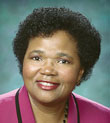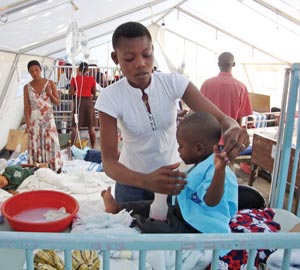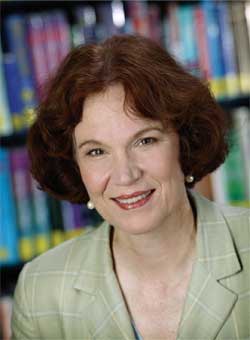Family Violence is a widespread problem in the United States, with deep societal roots and far-reaching impacts on health. Researchers at the school are leading efforts to identify, measure, and ultimately prevent the abuse that ruins so many lives.
Nurses long have been on the front lines providing care when violence erupts inside America’s families. But it’s only been in the last quarter-century that researchers have begun to unravel the pervasiveness of family violence and assess its impact on the health of the U.S. population.

The challenge today: designing prevention and intervention strategies to stop abuse before it leads to serious injury or death. Though nurse researchers have been doing this work for a long time, they haven’t always received the credit.
That may change. In January, President George W. Bush signed into law a measure that for the first time sets aside money for research by the nation’s health care systems into family violence. In the past, most research dollars have been funneled through the criminal justice system, in grants from agencies such as the federal Department of Justice. The new law, the Violence Against Women Act of 2005, which still needs to be appropriated, sets aside $13 million annually, over five years, for efforts by health care workers to combat family violence. It establishes money to test strategies to stop abuse before it leads to injuries or deaths.
“It’s an important shift,” says Jacquelyn Campbell, PhD, RN, FAAN, an international expert who has published more than 125 scholarly articles and six books on domestic violence. “It’s the first time we are getting funds to get better assessment and intervention in the health care system.”
The Johns Hopkins University School of Nursing is uniquely positioned to be at the forefront of this national research initiative. The school’s faculty includes some of the nation’s leading experts, like Campbell, in areas of research such as the prevalence of abuse, assessment of victim danger, forensic nursing, biobehavioral responses, and violence intervention strategies.
Many of these Hopkins nurse researchers have the advantage of forging partnerships with researchers in other Hopkins divisions, including the Johns Hopkins University School of Medicine and Bloomberg School of Public Health. Together, these research groups can test real-life intervention strategies in Baltimore schools, shelters, and emergency rooms. When strategies show promise, they can be put into practice with Hopkins nursing students, who work with Baltimore’s vulnerable populations.
“The problem of family violence is widespread and the roots are very deep in our society,” says Phyllis Sharps, PhD, RN, CNE, FAAN, associate professor. “But we are doing cutting-edge research here. We have people developing the science. We have people trying and testing interventions. We have people translating research findings and using the evidence to teach other professionals.”
Prevalence Research
At one area shelter, The House of Ruth Maryland, Hopkins nursing researchers conduct a clinic and gather information about the prevalence of the problem of domestic violence. Social workers, counselors, and nurses say the demand for services far exceeds the emergency help available. This shelter, for example, operates a 68-bed emergency shelter that houses women and children for an average of 45 days. The shelter turns away at least two times as many women and children as they take in. Counselors are so hard-pressed for space they can only take people under immediate threat of death or serious bodily harm.
Janice Miller, residential clinical director at the shelter, has found that women form a unique bond with their medical providers. “They will tell them things that they won’t tell their pastors, teachers, or neighbors,” she says.
Campbell says it is this special role of nurses that has allowed them to see and document the pervasiveness of the problem.
Domestic violence has a long history, but only recently have experts put names to conditions. In 1962, researchers coined the phrase “battered child syndrome.” It wasn’t until the 1970s that they began to identify “battered women.” The understanding of elder abuse is still in its infancy.
Today, says Campbell, scientists look at the range of abuse over a lifetime—child abuse and neglect; intimate partner abuse, involving a spouse or close partner; and elder abuse. Still, it’s difficult to understand the magnitude of the problem. Federal studies estimate family violence touches 25 percent of Americans as victims, witnesses, or perpetrators. Some statistics are staggering: Intimate partner violence, for example, accounts for about 22 percent of all violent crimes against women and 30 percent of female murders.
 Profile: Joan Kub, PhD, APRN, BC
Profile: Joan Kub, PhD, APRN, BC
Background: Public Health Nursing
Projects
Worked on early studies with Jacqueline C. Campbell looking at the prevalence and health consequences of domestic violence in military and civilian HMO populations. Her research today focuses on intervention strategies for prevention of youth violence, including dating violence and bullying behavior.
Biobehavioral Research
There’s no doubt this abuse is making millions of people sick. Abused individuals seek health care for a wide range of ailments. Some nurses refer to them as “frequent flyers” because they continually seek help for chronic health conditions—gastrointestinal pain, pelvic pain, fatigue, depression. “It’s like playing that children’s game, ‘Whack-A-Mole,'” says Nancy Woods, PhD, CNM. “You treat one thing but then something else pops up.”
Woods is at the forefront of research showing abuse not only causes physical problems, such as broken bones, urinary tract infections and sexually transmitted disease, but it also alters the body’s immune response.
Her research has been among the first nationwide to identify a significant relationship between intimate partner violence, post-traumatic stress disorder, and pain-fatigue-depression symptoms, and elevated pro-inflammatory cytokines in women with a history of abuse. These higher pro-inflammatory levels in the blood, which were not explained by other factors, can lead to profound physical and psychological changes in the body.
Woods concluded that even a history of abuse can lead to ailments years later, such as pain, fatigue, depression, and anxiety, which make activities such as holding down a job or caring for children more difficult. “The mental health effects are driving the physical response,” Woods says. “But if you think about it holistically, it makes sense… the body-mind-spirit are interconnected. What affects one aspect will impact the other.”
Woods, who conducts research at the Shepherd’s Clinic for the uninsured in Baltimore, says many health care professionals still don’t ask about abuse. She recalls one woman who came regularly to the clinic, but had never been identified as an abuse victim. During a routine screen for violence, Woods asked her: “At any time, have you ever been harmed physically by your partner?” The woman responded: “Well, of course…,” lifting her shirt to reveal a back marred by scars.
“It’s that old saying,” Woods says. “If you don’t take a temperature, you don’t find a fever.”
 Profile: Anne “Nancy” Woods, PhD, CNM
Profile: Anne “Nancy” Woods, PhD, CNM
Background: Nurse Midwifery
Projects
Conducted the first known study to examine the relationships among intimate partner violence, post-traumatic stress disorder, and inflammatory cytokines. Her findings: Women who reported a history of partner violence had higher levels of pro-inflammatory cytokines in their blood, which can cause profound physical and psychological changes. A patient once told her: “I was sick of the abuse, so I left him. Then I realized I was sick because of the abuse.
Assessment Research
It was that realization back in the late 1970s that led Campbell to develop one of the most widespread assessment tools used today to gauge the risk of intimate partner homicide.
Campbell was working as a nurse in an inner city high school in Dayton, Ohio, when she met a bright, young girl named Annie, pregnant by her boyfriend, Tyrone. Campbell supported the couple in their decision to keep the baby, Tyree. The couple even named her the child’s godmother. She kept in touch with the family for eight years. All seemed well. Then Tyrone killed Annie. Campbell was devastated. She had never suspected intimate partner abuse.
Hoping to avoid such future tragedies, Campbell developed a tool known as the Danger Assessment, which is now used throughout the U.S., Canada, and the world, and is part of the screening that Hopkins nurses use at clinics such as the House of Ruth Maryland.
In addition to taking a medical history, nurses ask women to mark on a calendar dates of past abuse. Incidents, ranked from least to most severe, include: slapping and pushing; punching, kicking, bruises; “beating up,” which means burns, broken bones and miscarriage; threat to use a weapon; and, finally, use of a weapon with wounds. This gives social workers and nurses an indication of those most in need of shelter: those at risk of being killed.
Assistant professor Daniel J. Sheridan, PhD, RN, CNS, FAAN, the son of a police officer and pioneer in the field of forensic nursing, has worked with Campbell to refine a similar assessment tool, called HARASS, to be used when women leave abusive situations. That, he says, is the time when women are most at risk. Sheridan recently received a $20,000 grant to test a shorter version of the self-reporting questionnaire, which will be easier to use in hospitals, emergency rooms, and shelters.
 Profile: Jacquelyn C. Campbell, PhD, RN, FAAN
Profile: Jacquelyn C. Campbell, PhD, RN, FAAN
Background: Pediatric and Community Health Nursing
Projects
Published 125 scholarly articles and six books on abuse, including Family Violence and Nursing Practice. Developed the first intimate-partner assessment questionnaire, the Danger Assessment, to gauge the risk of homicide to battered women. The assessment is used throughout the U.S. and Canada, as well as in Taiwan, Australia, and New Zealand. Current research focuses on intervention and prevention strategies. “Everywhere you look there are things happening,” says Campbell. “I am proud to have played some small part.” inflammatory cytokines.
Intervention Research
An even more challenging assignment for Hopkins nursing researchers is designing and testing prevention and intervention strategies that will blunt abuse. An array of programs currently are under development at the Johns Hopkins University School of Nursing: Joan Kub, PhD, APRN, BC, has been working on a program to prevent bullying behavior in a local Catholic school in Baltimore City by involving school administrators, teachers, and parents in educating students; Benita Walton-Moss, DNS, FNP, is working on a curriculum at the Broadway Center for small-group therapy to help female substance abusers who are also intimate partner abuse victims; Woods has launched a program to use telephone support to help victims of intimate partner abuse battle fatigue, pain, and depression and ready themselves for change.
Among the most promising intervention research is that being done by Phyllis Sharps, PhD, RN, CNE, FAAN. She developed a program called “Passport to Health,” which uses the structure of home nurse visitation to help minority women transition from emergency shelters into healthy situations in their own communities.
One success: Sharps worked with a 28-year-old woman who took refuge with a three-month-old at a local shelter after a particularly brutal beating. Sharps worked with the woman for over four months, getting her a breast pump so she could continue nursing even though she had to leave the shelter during the day to work. The woman was able to arrange an out-of-state transfer and transition to a safe independent life.
“This woman was just very, very committed to being the best mother she could be for her child,” Sharps recalls. “The child continued to thrive, she weaned her son at six months, the right time according to the American Association of Pediatrics, and growth and development were on schedule. Mom and baby continued to do well and there were no further incidents of abuse.”
Of nine women followed during the project, seven women reestablished themselves without further abuse, Sharps says.
This approach will be tested more broadly over the next five years as Sharps recruits 160 women in Baltimore and 160 women in Missouri who will receive one-on-one home visitation in hopes of breaking the cycle of domestic violence. The program, called the Domestic Violence Enhanced Visitation Program, or DOVE, has been funded with a $3.5 million grant from the National Institute of Nursing Research.
“We know home visitation works,” says Sharps. “Through this program we will be teaching women how to stay safe and how to keep their babies safe… We will be working to empower families to find resources so they can take care of their problems themselves.”
 Profile: Phyllis Sharps, PhD, RN, CNE, FAAN
Profile: Phyllis Sharps, PhD, RN, CNE, FAAN
Background: Maternal and Child Health
Projects
Launching a five-year, $3.5-million intervention program, Domestic Violence Enhanced Visitation Program (DOVE), in Baltimore and Missouri. DOVE will test home visit intervention as a way to keep abused women and babies safe from intimate partner violence. “The dove is a symbol of peace,” Sharps says. “I like to think we are creating more peaceful families.”
Forensic Research
Dan Sheridan, PhD, RN, FNE-A, FAAN, who started the School of Nursing’s master’s program in forensic nursing (one of just 10 in the nation), has seen his share of grisly injuries.
For the last two years, the former president of the International Association of Forensic Nurses has been working on a $300,000 research program, funded by the Department of Justice, to develop a curriculum to teach others how to identify neglect and abuse in vulnerable and elderly people.
Sheridan sees the project as a kind of bridge—connecting the research findings he’s made in the latest assessment and intervention strategies with nursing students who will be able to put them into practice in clinical settings. Through his research-based curriculum, for example, students learn that the shape of a bruise can indicate the difference between an intentional or accidental injury. They also learn the importance of taking detailed notes, since these can be used in court as evidence for the prosecution.
This past spring, Sheridan tested his curriculum in a pilot course that met weekly and drew nurses from across Maryland. The two-credit course will become available to nurses nationwide this year, and he hopes to offer it on CD-ROM to further expand its reach.
A jovial man, Sheridan arrived at his course one day last April wearing an M&M tie that shows a piece of candy playing the blues. “I wear this tie to remind all of you to take good notes,” he says. “Because when you are a nurse, what you observe and what’s in your notes is important.”
Cathy Daggett, a registered nurse who works for Maryland’s Kent County Health Department, says that Sheridan’s research-based instruction about family violence and elder abuse has been invaluable. She was only halfway through the course when she received a panicked call from an elderly woman, who complained about recent, bizarre behavior by her husband.
Daggett visited the home and interviewed family members to discover that the husband had been keeping the 80-year-old woman up nightly for a month, from 9 p.m. to 6 a.m., hitting her and screaming at her. “They had had a rough relationship,” she says, “but to my knowledge, he had never hit her before.”
She got in touch with the elderly man’s doctor. He was evaluated and found to be having an adverse reaction to a change in his medication. “I was able to look at the situation more objectively because of the course,” Daggett says. “Every working nurse in the country should have this training.”
 Profile: Daniel J. Sheridan, PhD, RN, FNE-A, FAAN
Profile: Daniel J. Sheridan, PhD, RN, FNE-A, FAAN
Background: Military-trained operating room technician. Forensic Nursing.
Projects
Completing a two-year program, under a $300,000 grant from the U.S. Department of Justice, to develop a nationwide curriculum to train nurses to recognize abuse and neglect in vulnerable and elderly people. Oversees Hopkins’ master’s program in forensic nursing, one of 10 forensic nursing programs nationwide. Worked with wife on battered women’s hotline. “My wife’s passion infected me,” says Sheridan.
By Mary Beth Regan–A Baltimore-based freelancer who writes frequently about health and science issues.
 When a Loved One Dies
When a Loved One Dies Alumni Profiles
Alumni Profiles How to Help Haiti
How to Help Haiti Class News
Class News Campbell Named IOM Scholar-in-Residence
Campbell Named IOM Scholar-in-Residence







